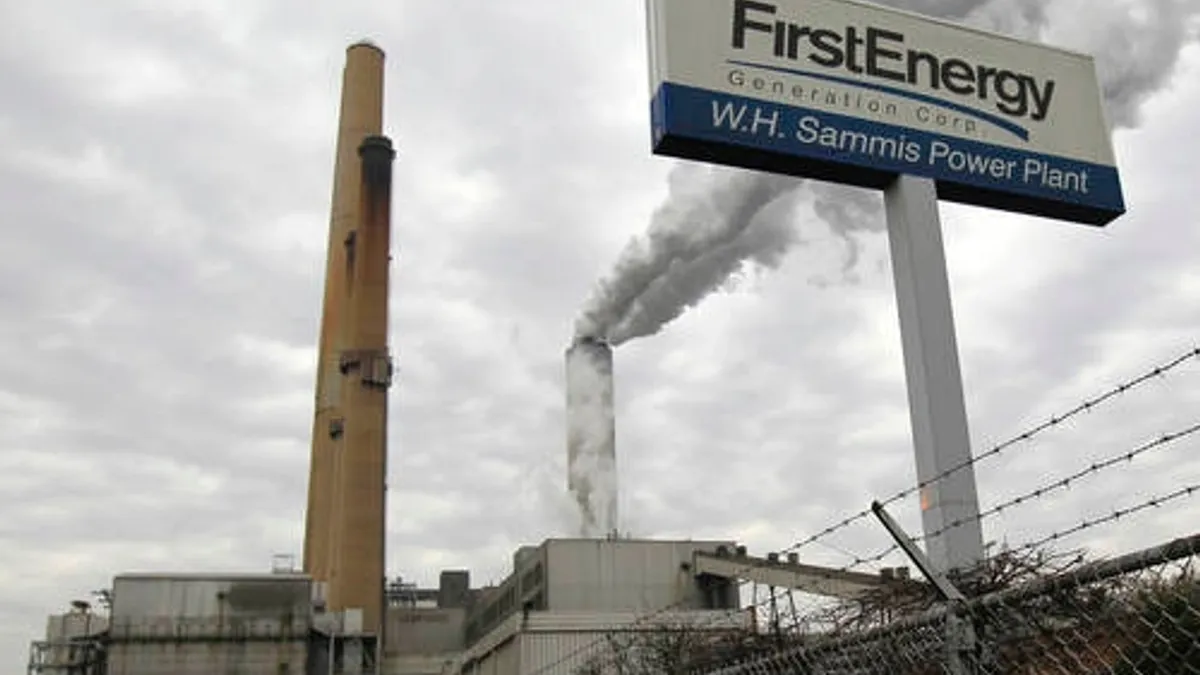Dive Brief:
- FirstEnergy Corp. announced Friday it will deactivate units at two Ohio fossil fuel generators, saying income from wholesale energy markets is not sufficient to keep them operating.
- The company said it plans to deactivate units 1-4 at the W.H. Sammis coal plant, as well as sell or retire unit 1 at its Bay Shore plant, fueled by petroleum coke. State regulators last year approved income supports for the Sammis plant, but they were blocked by the Federal Energy Regulatory Commission (FERC).
- Environmentalists who opposed the plant subsidies welcomed the decision, saying it will reduce power costs and emissions for Ohioans. But it remains unclear how FirstEnergy's move will affect two similar income support proposals from AEP and Dayton Power & Light.
Dive Insight:
In nearly two years of debate at the Public Utilities Commission of Ohio, FirstEnergy and its utility colleagues told regulators that Sammis and other aging baseload would be essential in preserving reliability and preventing an over-reliance on natural gas.
PUCO approved eight-year power purchase agreements last year for a group of coal and nuclear generators from FirstEnergy and AEP, but FERC blocked the subsidies over concerns of anti-competitive behavior.
FirstEnergy's PPA deal covered 3,300 MW of capacity at the Davis-Besse Nuclear Power Station in Oak Harbor, the Sammis plant in Stratton, and a portion of the output of Ohio Valley Electric Corporation (OVEC) units owned by its generating affiliate FirstEnergy Solutions.
AEP originally requested supports for 3,100 MW of older coal-fired generation in four plants. But after FERC's decision to halt the PPAs, the utility has downsized its proposal to 440 MW.
That plan is still under consideration by state regulators, as is a new proposal from Dayton Power & Light to cover 2,200 MW of coal generation across six plants. Those proposals were specifically crafted to apply to retail electric rates, rather than the wholesale markets, in an attempt to avoid FERC review.
For FirstEnergy, the regulatory process appears to have streteched too long for its most uneconomic units at the Sammis and Bay Shore plants, but they won't shutter the facilities completely. Units 5-7 at Sammis will "continue to provide 1,490 MW of reliable baseload generation," and the company indicated it is open to selling Bay Shore.
"We have taken a number of steps in recent years to reduce operating costs of our generation fleet," FirstEnergy Generation President Jim Lash said in a statement. "However, continued challenging market conditions have made it increasingly difficult for smaller units like Bay Shore and Sammis Units 1-4 to be competitive. It's no longer economically viable to operate these facilities."
Environmentalists welcomed the decision, but pledged to fight on to close the remaining coal generation in the state.
“Today’s announcement is further proof that Sammis is an outdated and costly coal plant that customers should not be forced to prop up," said Shannon Fisk, an Earthjustice attorney working for the Sierra Club on the proceeding. "We will continue to fight efforts that could be used to bail out other FirstEnergy coal units, as now is the time for significant investments in renewable energy, energy efficiency, and grid modernization activity that will create jobs and economic development throughout Ohio.”
The FirstEnergy announcement brings Ohio's total coal retirements since 2010 to 10,093 MW, the Sierra Club said in a statement, more than any other state, and about 9.5% of U.S. coal retirements in that timeframe.
That fact has not been lost on utility executives in the region. At a recent industry conference, the CEOs of AEP, Michigan's DTE Energy and other executives said they would redouble their efforts to reform organized markets to preserve aging baseload generation.














